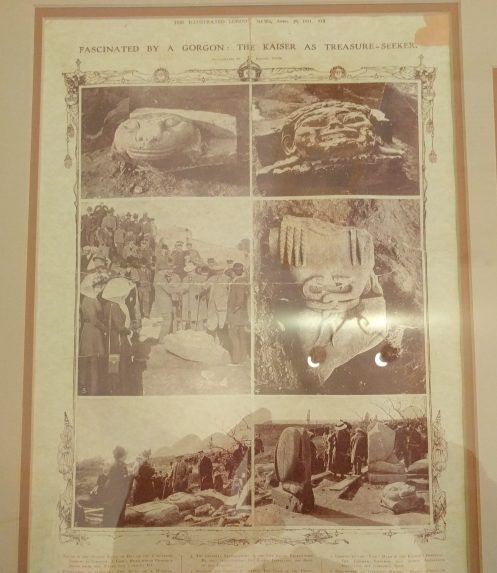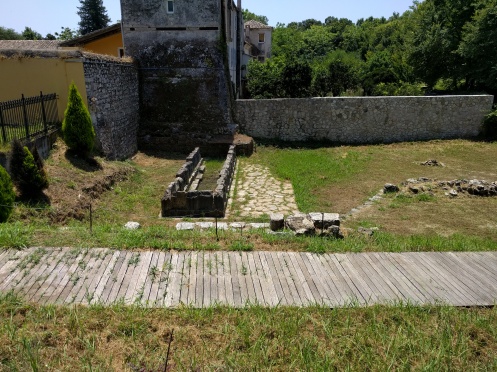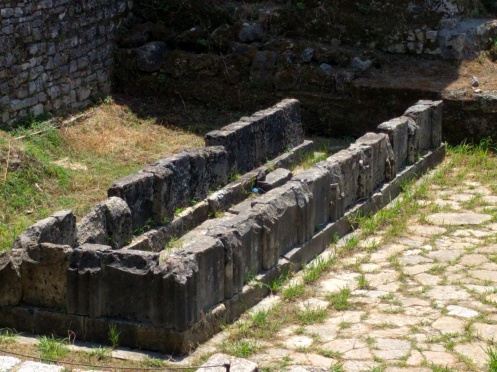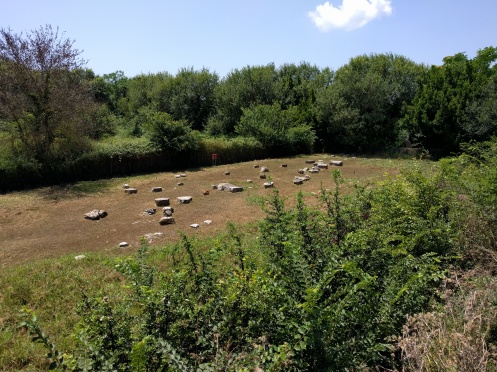Searching for the Sanctuary of Artemis
So after four years of studying and a rather epic year of dissertation work from 2015 to the start of 2016 I fell out of love with writing for a while. This site, and writing for it, went to the back of my mind as I realised that for a while I did not want to do anything with or for it. One year on I have started preparing my dissertation for publishing on my blog (I can finally bring myself to look at it again) and hopefully it will be ready to release next month. In the interim though I thought I would share something from my Greece trip last year.
Included on my itinerary was Corfu where I hoped to visit the archaeological museum and also the Sanctuary of Artemis whilst on the island. I was particularly excited to finally have the opportunity to see the ancient Gorgon pediment from the Temple of Artemis. I became quite fascinated with this piece of pedimental sculpture during my A level Classical Civilisation course. The Gorgon pediment is the earliest known form of pedimental sculpture dating to around 580 BC. Though later pediment sculpture depicts far more realistic representations of the form of a person or creature I have always found the depiction of the oversized Medusa to be an impressive piece; particularly as it is early in the development of the form. The positioning of the legs and body convey the urgency of the scene, Medusa is fleeing what can be deduced as the pursuit of Perseus (though the remains do not suggest he was depicted). Osborne (1998: 73) considers that the flat body of the lion compared with the rounded image of Medusa brings out the liveliness of the Gorgon. I agree with Osborne’s observation as through the rounding of the image of Medusa, alongside the implied movement in the positioning of the legs and arms, it appears as if she could run out of the pediment itself. The pediment and inclusion of Medusa’s children in the depiction is described by Woodford (2003: 42) as being ‘a cleverly concise and loaded image’. Superficially the presence of the children reminds the audience of the future following Medusa’s death but it conveys far more. If the scene is considered to be a fleeing Medusa the presence of Pegasos and Chrysaor also indicates urgency and her imminent death. A brief analysis of the representation of Medusa can be found here. Unfortunately my visit to the archaeological museum was not meant to be as the fates conspired against me.
In advance of the visit I read conflicting reports online about whether the museum refurbishments had been completed. I led Daniel (my better half) to the museum in the hope that it would be open but alas it was not. Having checked online prior to publishing this the Ministry of Culture and Sport in Greece states that renovation is due to be complete by the end of 2016 (http://odysseus.culture.gr/h/1/eh155.jsp?obj_id=3420). However, previous deadlines have not been met and as such it may not have reopened yet.
Following this disappointment we set out towards the Mon Repos estate where our guidebook informed us we could find the Sanctuary of Artemis (among other ancient sites and modern developments). The estate is exceptional for it’s archaeology and the museum on the site provides an interactive map of the estate showing the ancient buildings and where they are in relation to the modern developments:
The area highlighted is the Sanctuary of Artemis. I pride myself on my navigational abilities but on this occasion they let me down. After exploring the museum Daniel and I set out to find the Sanctuary which is located outside of the main estate. We used the above image as a map of the area as we had not seen any signposts and, I have to admit, I thought it sufficiently represented the local area. Attempt one resulted in a walk around the entire estate after taking a wrong turning and missing the road to the exit; the estate is beautiful so we were not that upset. Attempt two was a pretty long walk in the midday heat. After thirty minutes of walking down a track we came out at the area of Corfu Town on the top right of the map, only to be told by a cafe owner that the Sanctuary was on the estate and sent back the way we came. On attempt three we found a sign that pointed towards the Sanctuary. However, this was some distance from the main entrance to the estate. Thankfully there was a second sign, though it could have easily been missed as it was not in the best condition, that pointed us down a track.
For those visiting Corfu Town this year and wanting to find the Sanctuary I have included a map of where it is located. The countryside of Corfu is beautiful and is wonderful to explore. Here is a photo of me once we were finally on track. Though as you can see there was quite a long road ahead of us.
The Sanctuary ruins were discovered during the Napoleonic Wars and excavations carried out in 1911 by Greek and German archaeologists with the involvement of Kaiser Wilhelm II. The photo below is from the museum showing the discovery of some of the artefacts on the site:
Artemis was a chief deity of Corfu where she was worshipped under the epithet of ‘Mistress of the animals’ at her temple. Though the area around the temple has been developed in recent times it was likely to not have been that way when the sanctuary was originally built. Given the sanctuary’s location, and the epithet Artemis was worshipped under, the area would have originally been wooded and some distance from the main developments of ancient Corfu. The worship of Artemis as a goddess of nature, springs and wild animals likely commenced from the early prehistoric period. In the Classical period the worship of Artemis had developed to include, for example, epithets such as the goddess of childbirth and other aspects associated with motherhood and also as a huntress. These epithets changed depending on the location of her worship. The temple was built in the Doric order with eight columns to the front and seventeen along each side. The Temple was divided into the pronaos, cella and opisthodomos. Only ruins of the foundations are visible at the site along with the altar and remnants of the slate path that connected the altar and the temple. Below are some images of the site:
To those visiting Corfu/Corfu Town this year I hope that the above provides some assistance in (speedily) locating the Sanctuary of Artemis and a bit of insight into the site itself. I also hope that the archaeological museum has reopened and you will be able to see the sculptural treasures that were excavated.
Bibliography
Osborne, R. Archaic and Classical Greek Art, Oxford: Oxford University Press, 1998.
Woodford, S. Images of Myths in Classical Antiquity, Cambridge: Cambridge University Press, 2003.







We tried in vain to find the Temple or Artemis, twice! Still, we found the Heraion; it was a very atmospheric place.
If I return you’ve inspired me to make a third attempt!